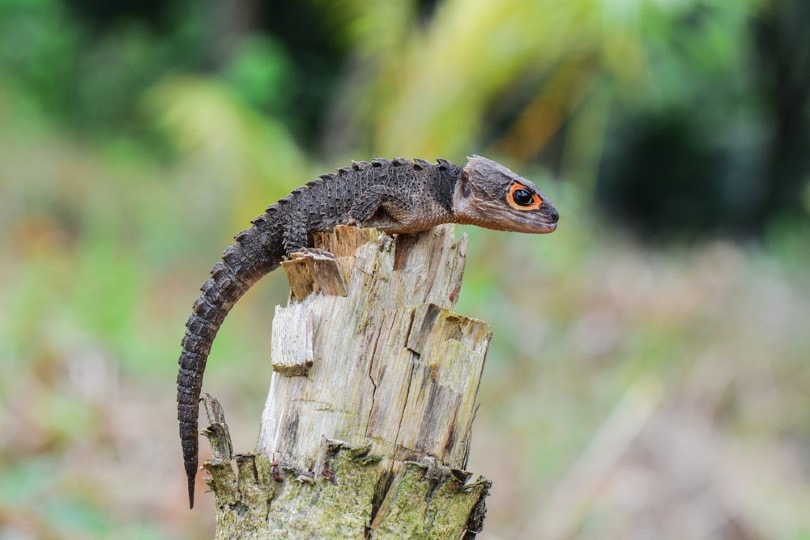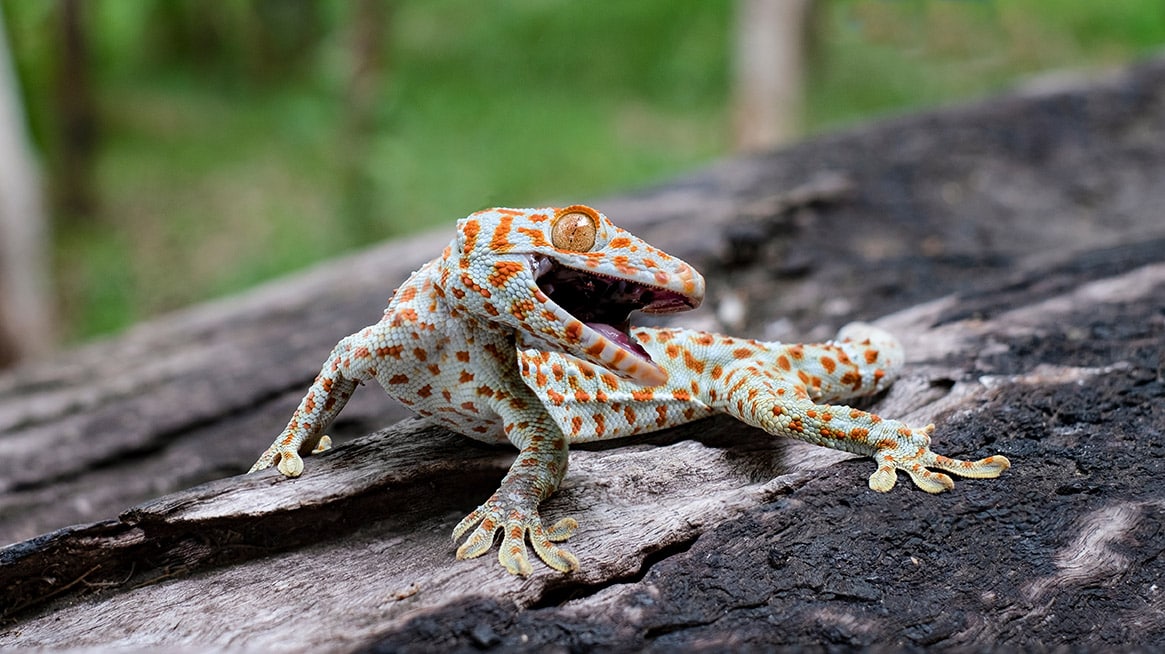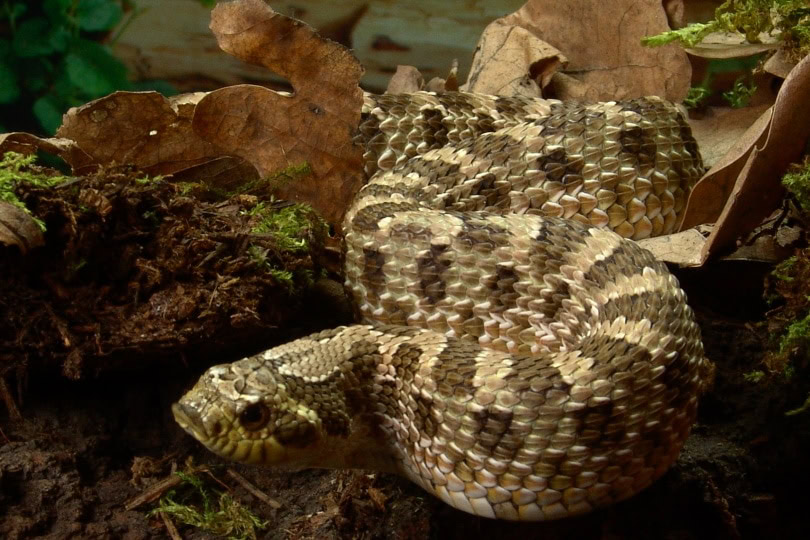Click to Skip Ahead
The red-eyed crocodile skink originated in southeast Asia. It is becoming increasingly popular as a pet due to its unique appearance. However, this species is not keen on being handled by humans, which puts off many people from owning one. If you do commit to one of these little critters, keep in mind that it can live up to 12 years.
This reptile needs a 10-gallon tank with gradated heat and a basking area. Their diet should be insects, and they will grow to a length of 10 inches. These skinks are relatively new to the pet world, only having been kept in captivity since the 1990s, so they are best regarded as display animals. Since they can become aggressive when two or more are kept in a tank together, breeding red-eyed crocodile skinks can be a challenge.
Read on to see whether this lizard is appropriate as a pet for you and if so, what you will need to ensure that it is comfortable, happy, and well cared for.

Quick Facts About the Red-Eyed Crocodile Skink
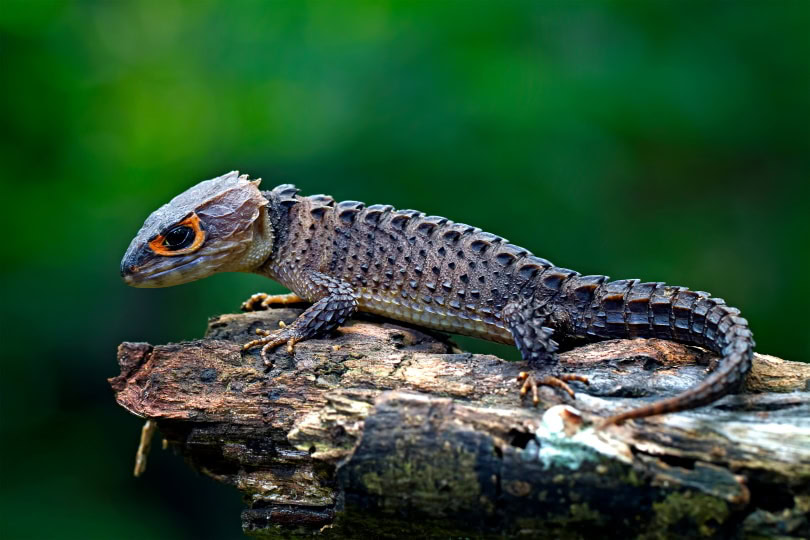
| Species Name: | Tribolonotus gracilis |
| Common Name: | Red-Eyed Crocodile Skink |
| Care Level: | Moderate to high |
| Lifespan: | 12 years |
| Adult Size: | 10 inches |
| Diet: | Insects |
| Minimum Tank Size: | 10 gallons |
| Temperature & Humidity: | 80% humidity, 80°F temperature |
Do Red-Eyed Crocodile Skinks Make Good Pets?
Red-eyed crocodile skinks have become increasingly popular as pets in recent years due to the unique markings around their eyes. However, they do not like to be handled, which means this is one type of lizard that is best kept as a display pet, rather than an active or interactive pet. As long as you just want to keep one to watch and study and can meet its requirements, it can make a good pet.
Appearance
Crocodile skinks have a spiny appearance, like that of a crocodile, and the red-eyed crocodile skink has an orange-red ring around both of its eyes. These are quite small lizards, with adults only growing to a length of 10 inches.

How to Take Care of a Red-Eyed Crocodile Skink
The proper care of a red-eyed crocodile skink requires the following tank, setup, and conditions to ensure a healthy and happy pet.
Habitat, Tank Conditions & Setup
Tank
Adults require a tank of a minimum size of 40” x 20” x 20” to ensure that they have ample room to explore and that you can meet their lighting and humidity requirements. This is also enough space to provide a basking spot, which is another essential component of a skink’s tank.
Lighting
This species of skink can benefit from UVB light, though some keepers and experts say that the crocodile skink is a nocturnal animal and does not require any UVB light. The species is considered crepuscular, which means that it is active during twilight hours. They should be given access to this type of light for 12 hours a day, which effectively provides a 12-hour day and a 12-hour night cycle for your little lizard.
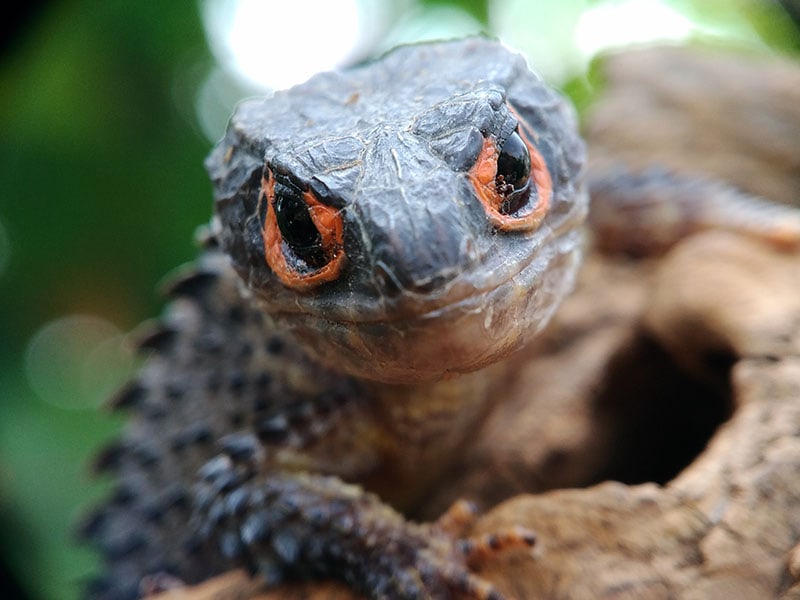
Heating (Temperature & Humidity)
The skink requires different temperatures during the day and night, and while some people argue that this lizard has not been seen basking in the wild, you should still provide a basking area. The tank should be kept between 75°F and 78°F, with a basking temperature of 82°F. Humidity should be above 70% but below 90%, so it is best to aim for around 80%.
Substrate
Good substrates mimic the wild conditions that the species would live in, including earthy and soil mixes. Some owners have reported success using damp paper towels as a substrate because these make it easier to achieve the desired humidity levels. These skinks also appreciate moss and should be given a pool or decent water source.
| Tank Recommendations | |
| Tank Type: | 10-gallon glass vivarium |
| Lighting: | UVB |
| Heating: | Basking lamp and heat mat |
| Best Substrate: | Soil |

Feeding Your Red-Eyed Crocodile Skink
The red-eyed crocodile skink is a small species of skink, which means that it will happily eat small crickets and hoppers. Expect to feed it live insects every 2 days or so, and ensure that these are dusted with a decent calcium supplement to keep your little lizard companion healthy. You can also feed it silkworms and red worms, in addition to other insects.
| Diet Summary | |
| Fruits: | 0% of diet |
| Insects: | 100% of diet; three insects every 2 days |
| Meat: | 0% of diet |
| Supplements Required: | Vitamin D3 and calcium dusting |
Keeping Your Red-Eyed Crocodile Skink Healthy
Always ensure that your skink has access to clean and fresh water and that the tank is kept at a constant and appropriate heat and humidity. Dehydration and the provision of incorrect temperatures are two of the most common ways that pet skinks suffer at the hands of their owners.
Common Health Issues
- Calcium deficiency is common, as it is with any other lizard.
- Tail autotomy means that the skink will lose its tail if it gets scared. A new tail will regrow, but you must keep the tank clean during the regrowth process to prevent bacteria and infections from forming.
- Bacteria growth can occur when the tank is not cleaned thoroughly or often enough. Clean weekly to ensure good health.

Lifespan
In the wild and in captivity, the red-eyed crocodile skink is expected to live between 10 and 12 years.
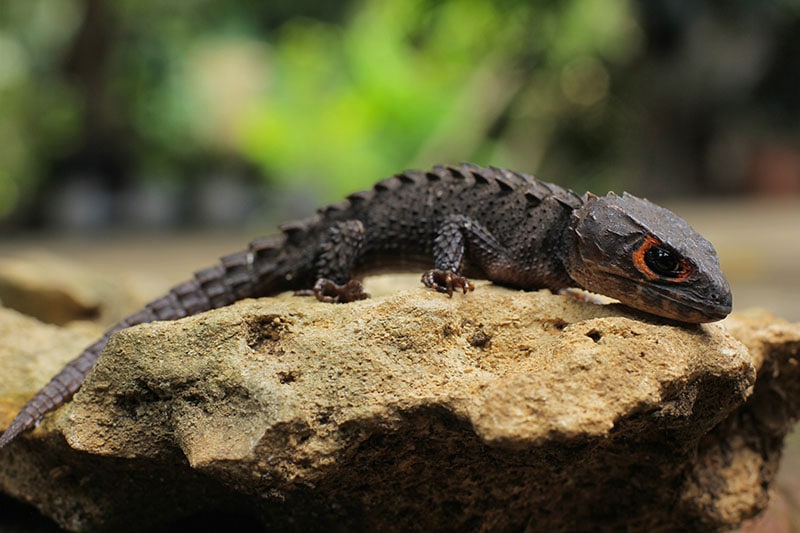
Breeding
In the wild, the female skink will lay one egg every week for 6 weeks during the wet season between December and March. In captivity, you can encourage breeding at any time by increasing the misting in your skink’s tank. These skinks are sexually mature at about 3 years of age, and a breeding pair, which can live together throughout the process, will require at least 3 square feet of space.
Are Red-Eyed Crocodile Skinks Friendly? Our Handling Advice
Not known for being good for handling, this species of skink may play dead if startled. It will freeze and then roll over as though dead. It may also drop its tail as a protection mechanism. Handling should be avoided, and you should avoid going into the tank at all unless it is necessary.
Shedding: What to Expect
The species will shed roughly every 4 to 6 weeks, and it does not usually have any difficulty as long as you keep the tank at the appropriate temperature and the right humidity level.

How Much Do Red-Eyed Crocodile Skinks Cost?
Although they are becoming increasingly popular as pets, the red-eyed crocodile skink remains relatively rare, and you should expect to pay approximately $200 for a good example of this species.
Care Guide Summary
- Unique look
- One of the few breeds to vocalize
- UVB light cycle is easy
- Handling is not recommended

Conclusion
Red-eyed crocodile skinks are becoming increasingly popular pets, but they remain rare in captivity and are display pets rather than interactive ones. They have a unique look, similar to that of a miniature crocodile but with red rings around their eyes, and are one of few lizards and even fewer skink breeds that can vocalize.
They are easier to look after than some breeds, though since they have only been kept as pets since the 1990s, we do not know too much about their specific requirements in captivity.
See also:
Featured Image Credit: DWI YULIANTO, Shutterstock
